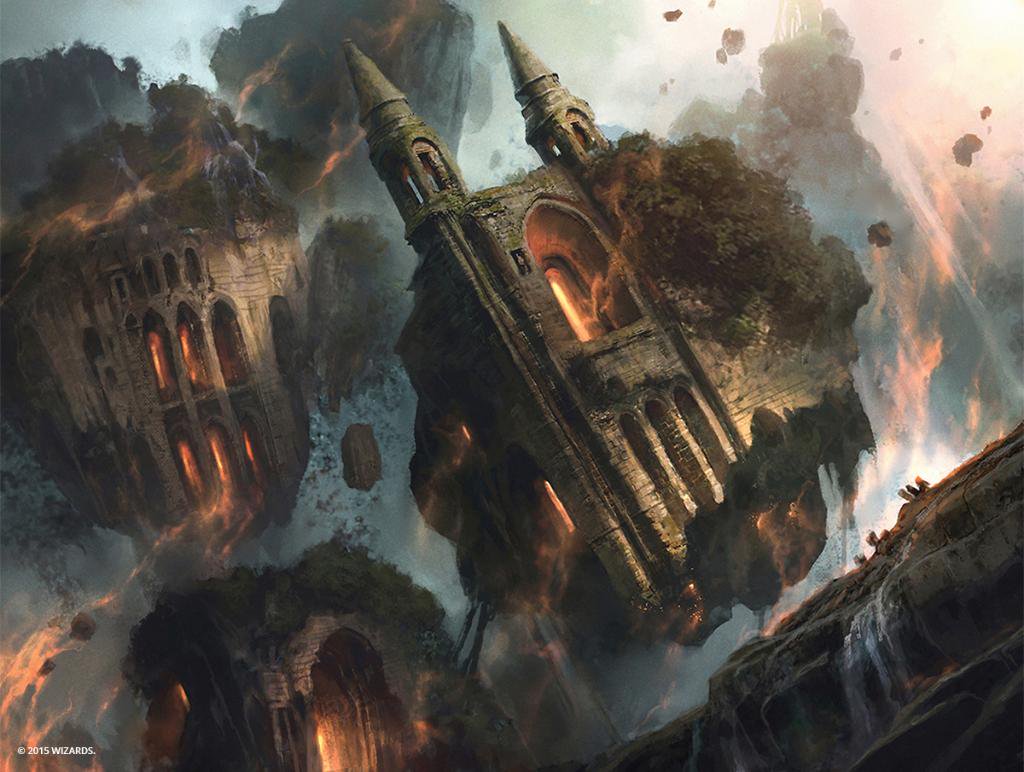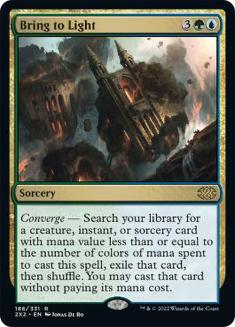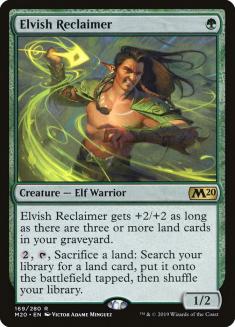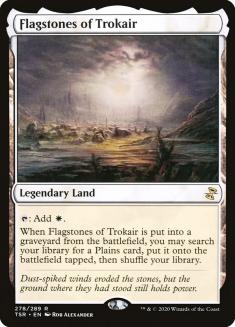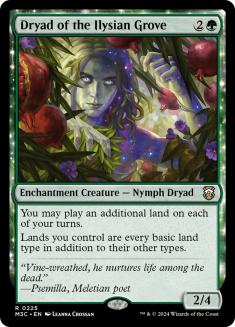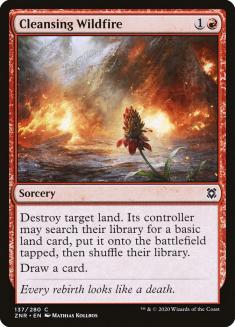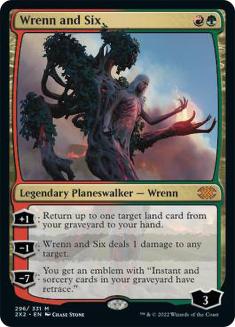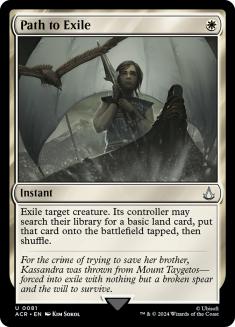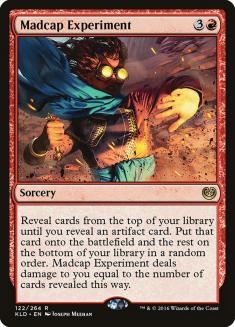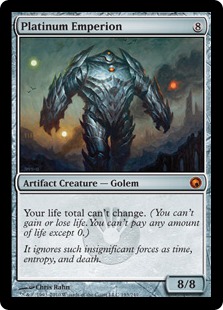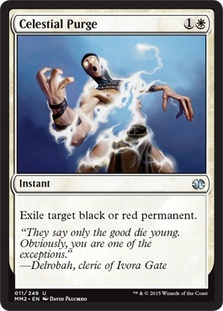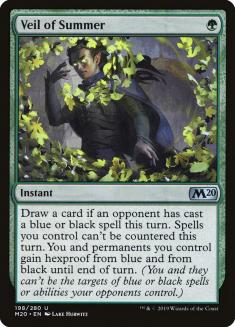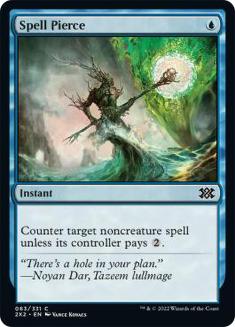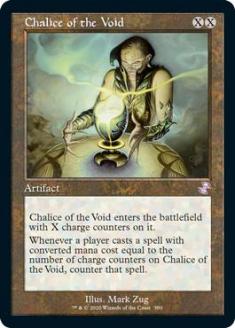Since the printing of Valki, God of Lies, Bring to Light has been near the top of my list in Modern. That interaction of being able to cast Tibalt, Cosmic Impostor on the cheap is impressive for a midrange or control deck. They changed the rules on cascade to help prevent it from happening too quickly, but it seems Bring to Light still works just fine. The trick is making sure you can leverage Bring to Light in situations outside of Tibalt, in a quest to turn it into one of the most powerful and versatile spells ever printed.
Modern has some really degenerate stuff going on at all times, so it only makes sense that the “fair” cards do something messed up as well. Bring to Light acts as your primary win condition alongside Scapeshift, a card advantage engine with Tibalt, and a reset button with Anger of the Gods or Supreme Verdict. It is literally the best spell in your deck because it’s always the best spell in your deck. It just so happens that if you have seven lands on the battlefield, your opponent is probably dead to Scapeshift. How convenient!
Today’s article will focus on a few different builds of Five-Color Control featuring Bring to Light as the build-around. These decks often look similar, but the devil is in the details. Figuring out the utility spells, the manabase, and win conditions is a delicate dance that takes hours of tuning, testing, and losing. Whenever you lose a game because you couldn’t cast a spell or didn’t have enough early interaction, you’ll find yourself cutting a card or changing a land out. It’s a labor of love, but one I’m fully committed to.
Which Version Is Best?
Let’s take a look at the first list:
Creatures (11)
Planeswalkers (2)
Lands (32)
Spells (15)

The addition of Flagstones of Trokair gives you a lot of wiggle room, allowing you to play multiple cards that help ramp while playing a fair game. Elvish Reclaimer with Flagstones of Trokair is exceptional, ramping you while providing a decent body to play around with. Importantly, Elvish Reclaimer gives you a way to tutor for Valakut, the Molten Pinnacle when you don’t draw Bring to Light.
While Elvish Reclaimer does some cool stuff, it also makes you vulnerable to cheap spot removal. In the past, we’ve built Scapeshift decks to dodge this kind of removal, but this build leans into it a little bit. We have a few more creatures than traditional versions, which can overload some removal, but I think the big draw is that all of our creatures are excellent on just about every turn where you can cast them. Normally a one-mana creature would diminish in value over time, but Elvish Reclaimer only gets better. Chances are it’s already huge if you’re casting it in later turns, and then it’s just a cheap way to tutor up Valakut or some other utility land. A 3/4 for one mana is nothing to sneer at, as it can clock your opponent in a pinch or put up some clutch blocks.
The secret weapon of the archetype, Dryad of the Ilysian Grove, makes Valakut, the Molten Pinnacle a realistic weapon instead of a clunky land that casts very little. It took off in Primeval Titan decks, but it’s nice to see it alongside Scapeshift. I played a bunch of Scapeshift back in the day and Prismatic Omen made for some sweet builds and cool kills. Tutor effects like Wargate actually made the cut because they were so versatile and could tutor up Valakut in a pinch. When you have a card on the table that turns Wargate into a ramp spell and damage engine, things start to cook. Dryad of the Ilysian Grove does the same thing, but now the tools are much more efficient.
Dryad of the Ilysian Grove is a perfectly acceptable, nay desirable, backup plan. It works fluidly inside the shell and significantly decreases the amount of pressure on your end-game. The fact that it has four toughness and dodges Lightning Bolt is a boon, but don’t sleep on it just playing a good defensive game. Having cheap creatures with high toughness that work in combo-centric ways is excellent in decks like this. Much like Baral, Chief of Compliance in Storm decks, your engine-creature can play some D on the post, and it comes in handy.
Lastly, I wanted to touch on how important it is for Dryad of the Ilysian Grove to fix your colors on occasion. Playing four copies each of Valakut and Flagstones makes for some weird combinations, but anyone who’s played the deck before knows how potent a single Dryad can be for making sure you can cast all your spells. I remember fondly when Prismatic Omen would allow Valakut to cast Wargate. Now we get to use Dryad to cast Omnath!
Cue The Lion King music…
It’s rare that you get a deck that so fluidly morphs between control, combo, and ramp. Cheap removal like Lightning Bolt and Path to Exile provide you the necessary tools to make it into the later turns of the game. Explore and other ramp effects push you toward Scapeshift more quickly without being bricks in the later turns. Explore is getting the nod here over Growth Spiral because it’s so much easier to cast, and does essentially the same thing.
With Growth Spiral getting banned in Standard, and Explore being such an essential part of ramp decks in the past, it’s no longer a secret just how good this type of effect can be. Rampant Growth and its ilk are great cards, but are absolute bricks when the game is on the line in the fourth quarter. Explore and Growth Spiral function on a different wavelength, offering a rebuy to anyone looking for action. The only “downside” is that you probably need to play 27 lands or so to make them viable. Otherwise, you’ll have too many early turns where casting Explore doesn’t allow for an extra land drop because you don’t have access to one in hand.
Playing “special” lands instead of searching up basic lands also has a lot of value. I’ve had countless games already where casting Explore let me play a fetchland, which in turn triggered Omnath, and the degeneracy commenced. You also don’t have a minimum basic land requirement, which makes building your four-color manabase a bit easier. We don’t have Arcum’s Astrolabe anymore, so our reliance on various multicolor lands has increased.
This tool for combating decks like Mono-Green Tron has been paired with Flagstones of Trokair plenty of times already, but it’s one of the neater interactions for a deck featuring Bring to Light. While it’s only a sideboard card right now, I wouldn’t be surprised to see it more widely adopted in the maindeck. It will be somewhat reliant on our opponents’ decks of choice, as a drastic shift toward Mono-Green Tron or other land-based strategies could warrant such changes. For now, a few in the sideboard are excellent thanks to their versatility.
Here’s another look:
Creatures (8)
Planeswalkers (6)
Lands (30)
Spells (16)

A return to Wrenn and Six means we’re less vulnerable to removal, and hit most of our land drops as the game goes on. One of the ways a Scapeshift deck loses is by missing your fifth or sixth land drop when you need to ramp up to seven. It’s a little less devastating these days because five mana can get you a juicy Bring to Light, where older versions would be stuck with useless copies of Scapeshift.
Wrenn and Six is one of the more ridiculous cards printed in the last few years. If you play it on the second turn and have a fetchland in the graveyard, it becomes a broken card advantage engine. The fact that it can also ping smaller creatures gives you a bit of play against more aggressive strategies. An uptick in various aggro decks, especially the ones featuring Clever Lumimancer, provide you with some additional value for your two-mana planeswalker.
It cannot be stressed enough how safe it feels to play a deck that has virtually no weakness to spot removal. Lightning Bolt in particular will almost always be going at your face, which is pretty great considering Omnath, Locus of Creation can give you a significant life buffer. Omnath should be a bigger part of this deck, in my opinion. I’ve seen people get away with playing one or two, but every single time I cast that card it goes gangbusters. You don’t even have to try. A single fetchland allows it to pay for itself. Casting it on the turn where you could hit five mana means it’s essentially free when casting Bring to Light.
There’s a good reason it was banned in Standard and Historic so quickly, and continues to be a major force in some of the formats where it’s legal. Omnath is also one of the cards that makes the “control” aspect of this deck possible. It singlehandedly generates a ton of mana, life buffer, and card advantage. It’s also a 4/4 for four mana, which dodges Lightning Bolt, and replaces itself the moment it enters the battlefield. Who could ask for more?
While Lightning Bolt and Path to Exile are prominent features in both builds, this iteration goes hard on the cheap spot removal in order to compete with the aggressive decks running around. Thanks to the printing of Clever Lumimancer, aggro is back in a big way. If you aren’t interacting in the first few turns, you’re likely dying on the spot. Going hard on Lightning Bolt makes a ton of sense because it doesn’t give them valuable resources. Path to Exile can really bite you in the ass against Lurrus of the Dream-Den, but Lightning Bolt is just the best.
The move toward a bunch of cheap spot removal gives you the breathing room you need to get your engine running. A lean on Lightning Bolt also gives you a backdoor out of killing your opponent with a Wrenn and Six ultimate. When you’re playing against an opponent who can counter or effectively deal with Scapeshift, it might leave you relatively light on win conditions. Having a few backdoor outs when things go south is essential for many successful Modern decks. As someone who’s won a few too many games with Snapcaster Mage beatdown, let me tell you just how important it is to be able to win when your things don’t break your way. Scrapping together some gameplan when you have no business winning is a patented Todd Anderson move.
Sideboard Spotlight
This two-card combo is essentially a one-card combo. Like Scapeshift, you don’t have to do a lot to set it up. It doesn’t always win the game, but it can buy you time in matchups where you might not have enough. Two sideboard slots to turn Bring to Light into something unique is a small price for one of the most game-breaking plays against a Burn deck. When you play four copies of Madcap Experiment and two copies of Platinum Emperion, your draws can get clunky, redundant, and ultimately lose you the game. When you can play one of each thanks to Bring to Light, the equation changes quite a bit.
One of the more disgusting tools printed in a long time, there’s a good reason it has seen maindeck play in a number of formats. It’s a little more balanced in Modern because there are so many viable strats, but it’s still a kick in the teeth for Primeval Titan decks or similar. It’s especially obnoxious for your opponent when they have Cavern of Souls and you’re still able to keep them off balance for a turn.
The fact that Aether Gust doubles as a counterspell for ramp and removal spell for aggro is hilarious. It’s so useful in so many spots. I kind of hate how good it is, but we’re going to keep using it as long as we can.
Like Aether Gust, Celestial Purge answers a number of different threats. While it might not be as powerful as Aether Gust, it’s certainly one of the better answers for Death’s Shadow or Liliana of the Veil, two very annoying threats that attack you in different ways. Like Aether Gust, it’s also excellent against many aggro decks.
This is one of the more unique spells in Magic’s history, acting as a burst of life and battlefield presence. It’s like a sorcery version of Kitchen Finks but gains significantly more life, offsetting the more robust draws from Burn decks that feature Boros Charm. The three small bodies often trade with a creature too, which just makes it one of the more disgusting answers to a very annoying problem. Thanks to the widespread adoption of Skullcrack, cards like Kor Firewalker have lost a lot of their luster because most of their value comes from blocking.
I want to stress that I hate this card, but only because it’s so outrageously good. Luckily for us, we don’t have a ton of interaction in our deck that gets hosed by an opposing Veil of Summer, which is a plus when it’s one of the more widespread sideboard options thanks to the dual nature of owning Thoughtseize and Cryptic Command.
If our opponent is trying to counter our spells, Veil of Summer is key. If they’re grinding us down with discard, it can be a potent defense mechanism for making sure we have enough resources to play a longer game. When it shines, your opponent will probably lose the game because of it. With that said, don’t be afraid to cycle it when your opponent casts random spells if you’re in desperate need of some action. It’s a great protective piece, but cycling it when it’s bad is one of the more important function of the card, and it’s imperative that you understand when to cycle it.
These two counterspells are a nice way to interact with weird stuff, but it’s rare that you’ll need them to win the game. They’re nice to have, but are clunky in multiples, as your deck plays at sorcery speed most of the time. I’ve seen Spell Pierce do some dirty stuff in my day, and having it be a protective element for your combo turns is nice when your opponent is low, but the primary function will be protection from a planeswalker or discard effect in the early turns. If your opponent is some sort of spell-based combo, a single Spell Pierce in the early-game might catch them off-guard, as your deck’s “normal” interaction doesn’t involve counterspells.
Negate is a little more robust in what it can interact with and when you can interact with it. Being able to hard counter an opponent’s expensive spell is a disaster for them. Not only does it stifle their development, doing so will often create a window where you can resolve one of your boom-booms. Do you know how good it feels to counter a Teferi, Hero of Dominaria when they’re not expecting it? Nice Dovin’s Veto, dummy.
Choose Your Destiny
These two builds are fairly similar, and both have had success recently. I’m currently more into the second build from SoulStrong, as Wrenn and Six has always felt spectacular in this archetype. Flagstones of Trokair and Elvish Reclaimer are quite strong, but I’m not currently into getting tagged by Lightning Bolt. Flagstones of Trokair is also a little awkward in the early turns because it doesn’t exactly cast much.
The decklist is clean, offers diverse gameplay, and gives the pilot a lot of wiggle room to make decisions. Bring to Light is such a powerful card, and is essentially whatever you need it to be in any given situation. The only “trick” is to play four or five colors so you can tutor up just about anything under the sun. A single Anger of the Gods becomes five virtual copies. A single win condition like Scapeshift gets less clunky because you don’t flood on them. Ramp like Explore pushes you toward Bring to Light without sacrificing late-game potential. Every part of this deck works together in harmonious ways. For a deck with so many colors, I was surprised at how little trouble I had actually casting my spells. Original versions with Growth Spiral were a little more taxing, but this iteration might be perfect.
I’ve been a Scapeshift stan for as long as I can remember, so it’s good to see that type of control/combo gameplay become mainstream again. I’ve been focusing more on Historic lately than anything else, but it’s nice to play another format now and again to get the creative juices flowing. There have been a lot of cards printed in the last few years that juiced this archetype up, but I have yet to find that anything feels heinously overpowered or unbalanced. Obviously Omnath is disgusting if left unchecked, but it’s Modern. You can die on the second turn.
Bonus Decklist
This archetype has had a lot of eyes on it recently, so it’s nice to see variations as people experiment to plug the holes in your gameplan. One user, DaVinciMtg (aka MtgVinci on Twitter), has gone so far as to play Chalice of the Void in order to fend off some of the more disgusting draws from Prowess builds. Here’s the list:
Creatures (7)
Planeswalkers (4)
Lands (29)
Spells (20)

I’m wary of Growth Spiral now over Explore, but Mana Leak and other instants mean we should be trying to play a little more of a tricky game. Just be careful on how you sequence your mana! My first few games with the deck had me stumbling on trying to balance Growth Spiral, Wrenn and Six, and Mana Leak. Valakut, the Molten Pinnacle certainly doesn’t help, and the fact that it enters the battlefield tapped puts some pressure on you in the early development turns. Just pay attention to your sequencing and think about what lands will cut off avenues or topdecks. Fetching the right lands can be crucial as well.
Chalice of the Void is the all-star here, absolutely shutting down opponents who have a reliance on one-mana spells. We’re sacrificing our Lightning Bolts and such here, and I’m not sold that it’s worth it yet, but it’s certainly worth thinking about. I don’t love that there are no “fast mana” ways to cast it on the first turn, but they banned Simian Spirit Guide, so what’re you gonna do? Play Gemstone Caverns in your five-color deck?

